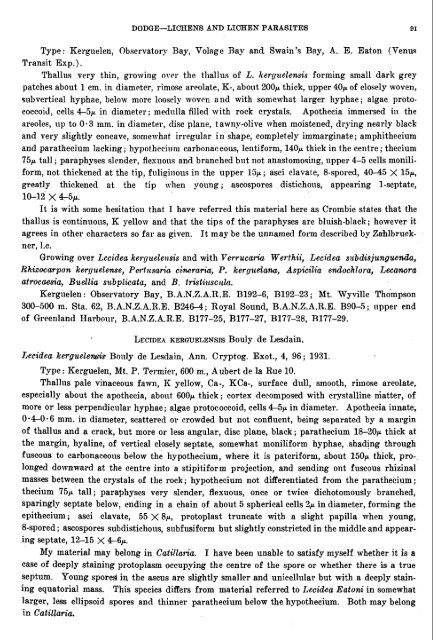Create successful ePaper yourself
Turn your PDF publications into a flip-book with our unique Google optimized e-Paper software.
DODGE-<strong><strong>LICHEN</strong>S</strong> <strong>AND</strong> <strong>LICHEN</strong> <strong>PARASITES</strong> 91<br />
Type: Kerguelen, Observatory Ray, Volage Ray and Swain's Bay, A. E. Eaton (Venus<br />
Transit Exp.) .<br />
Thallus very thin, growing over the thallns of L. lcergzielensis forming small darlr grey<br />
patches about 1 cm. in diameter, rimose areolate, K-, about 200p thick, uppcr 4OP of closely woven,<br />
subvertical hyphae, below more loosely woven and with somewhat larger hyphae; algae protococcoicl,<br />
cells 45p in diameter; medulla filled with rock crystals. Apothecia immersed in the<br />
areolcs, ny to 0.3 mm. in diameter, disc plane, tawny-olive when moistened, drying nearly black<br />
and very slightly concave, somenrhat irregular in shape, completely immarginate; amphithecium<br />
and parathecium lacking; hypothecium carbonaceous, lentiform, 140p thick in the centre; thecium<br />
75p tall ; paraphyses slender, flexuous and branched but not anastomosing, upper 4-5 cells moniliform,<br />
not thickened at the tip, fuliginons in the upper 15p; asci clavate, 8-spored, 4045 X 25p,<br />
greatly thickened at the tip wl~en young ; ascospores distichous, appearing 1-scptate,<br />
10-12 X 4-5/L.<br />
It is with some hesitatioii that I have referred this material here as Crombie states that the<br />
thallus is continuous, K yellow and that the tips of the paraphyses are bluish-black; however it<br />
agrees in other characters so far as given. It may be the unnamed form described by Zahlbruckner,<br />
1.c.<br />
Growing over Lecidea kergtcele~~sis and with Verrucaria Werthii, Lecidea s~cbdisjzcngue.nda,<br />
Rhizocarpon kergueltwe, Pert?csa& cineraria, P. kerguelam, Aspicilia endochlora, Leca.wra<br />
atrocaesia, Buellia subplicata, and B. tristizucrcln.<br />
Kerguelen: Observatory Bay, B.A.N.Z.A.R.E. B192-6, B192-23; Mt. Wyville ~hom~son<br />
300-500 m. Sta. 62, R.A.N.Z.A.R.E. B246-4; Royal Sound, B.A.N.Z.A.R.E. B9O-5; llpper end<br />
of Crcenland Harhour, B.A.N.Z.A.R.E. B177-25, R177-27, R177-28, R177-29.<br />
LECIDEA KERGIUEIAENSIS BOU~Y de Lesdain.<br />
Lecidea kerguelewis Bouly de Lesdain, Ann. Cryptog. Exot., 4, 96; 1931.<br />
Type: Kerguelen, Mt. P. Termier, 600 m., Aubert de la Rue 10.<br />
Thallus pale vinaceous fawn, IC yellow, Ca-, KCa-, surface dnll, smooth, riinose areolate,<br />
especially about the apothecia, about 600p thick; cortex decomposed with crystalline niatter, of<br />
more or less perpendicular hyphae; algae protococcoid, cells P5p in diameter. Apothecia innate,<br />
0-4-0-6 mm. in diameter, scattered or crowded but not confluent, being separated by a margin<br />
of thallus and a crack, but more or less angular, disc plane, black; parathecium 18-20p thick at<br />
the margin, hyaline, of vertical closely septate, somewhat moniliform hyphae, shading through<br />
fuscous to carbonaceous below the hypothecium, where it is patcriform, about 150p thick, pro-<br />
longed downward at the centre into a stipitiform projection, and sending oilt fuscous rhizinal<br />
masses between the crystals of the rock; hypothecium not differentiated from the parathecium;<br />
thecium 75p tall; paraphyses very slender, flexuous, once or twice dichotomously branched,<br />
sparingly septate below, ending in a chain of about 5 spherical cells 2p in diameter, forming the<br />
epithecium ; asci clavate, 55 X 8p, protoplast truncate with a slight papilla when young,<br />
8-spored ; ascospores subdistichous, subfusiform but slightly constricted in the middle and appear-<br />
ing septate, 12-15 X 4-6p.<br />
My material may belong in Catillan'a. 'I have been unable to satisfy myself whether it is a<br />
case of deeply staining protoplasm occupying the centre of the spore or whether there is a true<br />
septum. Young spored in the ascus are slightly smaller and unicellular but with a deeply stain-<br />
ing equatorial mass. This species differs from material referred to liecidea Eatoni in somewhat<br />
larger, less ellipsoid spores and thinner parathecium below the hypothecium. Both may belong<br />
in Catillaria.

















